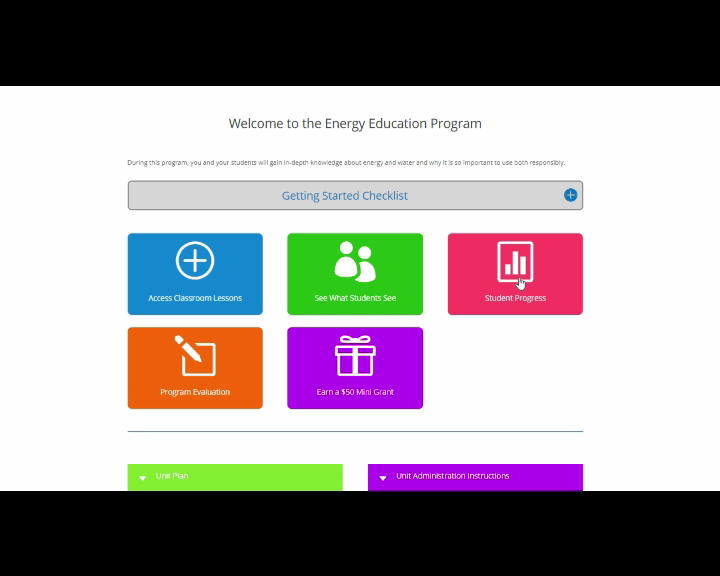
See the TEKS supported in this unit.
English Language Arts and Reading
1. Developing and Sustaining Foundational Language Skills: Listening, Speaking, Discussion, and Thinking – Oral Language
The student develops oral language through listening, speaking, and discussion. The student is expected to:
-
(1)(C) Give an organized presentation employing eye contact, speaking rate, volume, enunciation, natural gestures, and conventions of language to communicate ideas effectively.
- Students are instructed on how to present their findings about water usage and conservation through visual and oral means.
-
(1)(D) Work collaboratively with others to develop a plan of shared responsibilities.
- Collaborative activities encourage students to develop group plans for water-saving practices.
2. Developing and Sustaining Foundational Language Skills: Vocabulary
The student uses newly acquired vocabulary expressively. The student is expected to:
-
(2)(A) Use print or digital resources to determine meaning, syllabication, pronunciation, and word origin.
- Vocabulary related to water cycles (e.g., evaporation, condensation) is introduced, and students are encouraged to look up unfamiliar terms using print or digital resources.
-
(2)(B) Use context within and beyond a sentence to determine the relevant meaning of unfamiliar words or multiple-meaning words.
- Context clues are provided to help students understand complex terms like “reservoir” and “aquifer.”
3. Comprehension Skills: Listening, Speaking, Reading, Writing, and Thinking Using Multiple Texts
The student uses metacognitive skills to both develop and deepen comprehension of increasingly complex texts. The student is expected to:
-
(3)(A) Establish purpose for reading assigned and self-selected texts.
- Students are tasked with identifying the purpose of reading various texts on water conservation and determining how they relate to the local community.
-
(3)(F) Make inferences and use evidence to support understanding.
- As students learn about how drought affects local water supplies, they make inferences about the implications of low water levels and use evidence from the text to support their ideas.
4. Response Skills: Listening, Speaking, Reading, Writing, and Thinking Using Multiple Texts
The student responds to an increasingly challenging variety of sources that are read, heard, or viewed. The student is expected to:
-
(4)(A) Describe personal connections to a variety of sources, including self-selected texts.
- Students are encouraged to connect their own experiences with water conservation and droughts to the texts they read.
-
(4)(C) Use text evidence to support an appropriate response.
- Students write responses to questions about the environmental effects of building new reservoirs, using text evidence to support their answers.
5. Multiple Genres: Listening, Speaking, Reading, Writing, and Thinking Using Multiple Texts
The student recognizes and analyzes genre-specific characteristics, structures, and purposes within and across increasingly complex traditional, contemporary, classical, and diverse texts. The student is expected to:
- (5)(A) Demonstrate knowledge of distinguishing characteristics of well-known children’s literature such as folktales, fables, legends, myths, and tall tales.
- Students read fables and myths related to water conservation and analyze how different cultures approach water usage.
6. Author’s Purpose and Craft: Listening, Speaking, Reading, Writing, and Thinking Using Multiple Texts
The student uses critical inquiry to analyze the authors’ choices and how they influence and communicate meaning within a variety of texts. The student is expected to:
- (6)(A) Explain the author’s purpose and message within a text.
- The author’s purpose is to inform readers about the importance of understanding the water cycle and its impact on weather patterns and droughts, which students explain in discussions.
Math
5.3 Number and operations.
The student applies mathematical process standards to represent and explain fractional relationships. The student is expected to:
- (K) Solve real-world problems involving multiplication and division of fractions.
- Students calculate water savings using fractions and multipliers in activities related to high-efficiency devices and conservation kits.
5.4 Algebraic reasoning.
The student applies mathematical process standards to develop concepts of expressions and equations. The student is expected to:
- (C) Generate a numerical pattern when given a rule in the form y = ax or y = x + a and graph.
- Students use rules and equations to determine water savings and represent data numerically and graphically.
5.10 Data analysis.
The student applies mathematical process standards to solve problems by collecting, organizing, displaying, and interpreting data. The student is expected to:
- (A) Represent categorical data with bar graphs or frequency tables.
- Students create tables and charts to track and display water usage patterns.
Science
5.1 Scientific investigation and reasoning.
The student conducts classroom and outdoor investigations following home and school safety procedures and environmentally appropriate and ethical practices. The student is expected to:
- (B) Make informed choices in the conservation, disposal, and recycling of materials.
- Discusses valuing clean water and reducing waste.
- Emphasizes using water efficiently and preventing waste.
- Outlines activities such as calculating water savings with Water Conservation Kits, measuring water usage, and completing homework exercises to reinforce conservation concepts, which encourage students to make informed decisions about water use at home and school.
- Includes a challenge where students calculate water savings from using water-saving kits, reinforcing the practice of making informed decisions on water use.
5.6 Matter and energy.
The student knows that matter has measurable physical properties that determine how matter is identified, classified, changed, and used. The student is expected to:
- (A) Compare and contrast matter based on measurable, testable, or observable physical properties.
- Discusses various water uses at home and the concept of measuring water usage.
- Introduces how water is stored in different physical states and how properties like volume and temperature affect water management.
- The workbook engages students with hands-on activities like calculating weekly water usage, allowing them to observe and measure water consumption based on specific activities.
- Students learn how to measure water flow and analyze fixture efficiency, which reinforces their understanding of physical properties like volume and flow rate.
5.7 Force, motion, and energy.
The student knows the nature of forces and the patterns of their interactions. The student is expected to:
- (A) Investigate and explain how equal and unequal forces acting on an object cause patterns of motion and transfer of energy.
- Describes the water cycle and how energy transfers in the form of heat (evaporation and condensation), demonstrating energy transfer in a system.
- Involves the use of the Water Conservation Kit, where students calculate water savings, reinforcing the energy transfer in systems related to water usage.
- The “Water Conservation Kit Challenge” includes activities where students explore how force (water pressure) influences the efficiency of water fixtures, which directly relates to the transfer of energy within the water conservation system.
5.8 Earth and space.
The student understands that there are recognizable patterns in the natural world and among the Sun, Earth, and Moon system. The student is expected to:
-
(A) Differentiate between weather and climate.
- Describes how Texas climate influences drought patterns.
- Discusses differences between weather and climate.
- Uses videos and visuals to teach students about weather and climate.
- Students analyze weather data to distinguish between short-term and long-term patterns.
-
(B) Explain how the Sun and the ocean interact in the water cycle.
- Detailed explanation of the water cycle and the Sun’s role in evaporation.
- Evaporation experiment connects the Sun’s role to ocean interactions.
- Students explore evaporation and condensation processes in the water cycle.
-
(C) Collect and analyze data to identify sequences and predict patterns of change in the natural world.
- Includes classroom activities to calculate water use and predict consumption trends.
- Students use conservation kits to track and analyze water use data.
5.9 Organisms and environments.
The student knows that there are relationships, systems, and cycles within environments. The student is expected to:
- (C) Predict the effects of changes in ecosystems caused by living organisms, including humans, such as the building of new reservoirs.
- Discusses the environmental and social impact of building reservoirs.
- Explores the consequences of new reservoirs on habitats and communities.
- Students brainstorm the positive and negative consequences of reservoirs.
- Students evaluate ecosystem changes due to human interventions.
Social Studies
6.8 Geography – The student understands how people adapt to and modify their environment.
-
(A) Describe how and why people have adapted to and modified their environment in the United States such as the use of human resources to meet basic needs.
- Discusses efforts like the “Smart Flush” program in Fort Worth, which modifies water usage habits through the installation of water-efficient systems.
-
(B) Analyze the positive and negative consequences of human modification of the environment in the United States.
- Describes the creation of reservoirs and the benefits they provide for water supply systems, while also acknowledging the ecological consequences of damming rivers and flooding areas for water storage.
6.10 Economics – The student understands the development, characteristics, and benefits of the free enterprise system in the United States.
- (C) Give examples of the benefits of the free enterprise system in the United States.
- Describes the distribution of low-flow toilets in Fort Worth, illustrating the benefits of a market-driven approach to water conservation products and services.
6.17 Citizenship – The student understands the importance of individual participation in the democratic process at the local, state, and national levels.
- (A) Explain why individuals have a duty to participate in civic affairs at the local, state, and national levels.
- Encourages student participation in water-saving actions, emphasizing individual responsibility in water conservation as part of civic duties.



